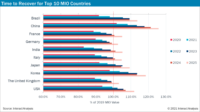JOHANNESBURG, South Africa — Global capital project and infrastructure spending is expected to grow to more than $9 trillion annually by 2025, up from $4 trillion in 2012, according to a new report issued by PwC, "Capital project and infrastructure spending: Outlook to 2025."
The report, for which Oxfords Economics provided research support, analyzes infrastructure spending across 49 of the world’s largest economies, which account for 90 percent of global economic output. It covers five industry sectors — extraction, utilities, manufacturing, transport and social — and forecasts their impact on seven major world economic regions: Western Europe, Latin America, Asia-Pacific, Middle East, sub-Saharan Africa, Former Soviet Union and Central and Eastern Europe. It estimates the scale of current infrastructure investment and assesses the prospects for future investment from now to 2025. Overall, close to $78 trillion is expected to be spent globally between now and 2025 on capital projects and infrastructure.
Jonathan Cawood, PwC Head of Capital Projects and Infrastructure for Africa, said, “Emerging markets, especially China and other countries in Asia, without the burden of recovering from a financial crisis, will see much faster growth in infrastructure spending.The pace of urbanization is also on the increase, with the biggest shift in urbanized populations, likely in China, India, Ghana, Nigeria and the Philippines. Urbanization drives the demand for water, power, transportation and technology infrastructure."
Overall infrastructure spending in the sub-Saharan region is projected to grow by 10 percent a year over the next decade — exceeding $180 billion by 2025 — while maintaining its two pecent share of the global infrastructure market. Nigeria and South Africa dominate the infrastructure market, but other countries like Ethiopia, Ghana, Kenya, Mozambique and Tanzania also arepoised for growth. Growth prospects in most of the region’s economies look promising, as they were not affected as much by the global financial crisis of 2008.
In addition, climate-related disasters are driving growth in preventative infrastructure spending and in post-disaster recovery. Climate change also is spurring investments in water resources, renewable energy and clean technologies.
For more information, visit www.pwc.com.



